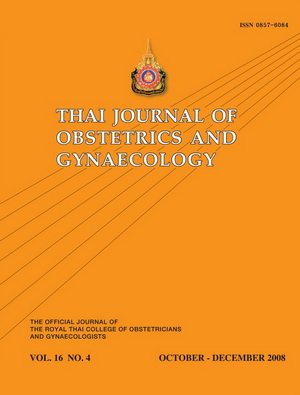Outcome of The Management of Women with “Atypical Squamous Cells” in Cervical Cytology after Colposcopy
Main Article Content
Abstract
Objective: To study and compare the outcomes of the management of women with cervical
cytology interpreted as atypical squamous cells of undetermined significance (ASC-US) and
atypical squamous cells cannot exclude high-grade squamous intraepithelial lesion (ASC-H)
after colposcopic evaluation.
Study design: Retrospective descriptive study.
Setting: Nakornping Hospital, Chiang Mai, Thailand.
Materials and Methods: Medical records of 254 women with cervical cytology of ASC-US and 75
women with cervical cytology of ASC-H, who underwent colposcopy at colposcopy clinic of
Nakornping hospital from October 2003 to September 2007 were retrospectively reviewed.
The data was analyzed and compared between two groups of abnormal cervical cytology.
Results: Of 254 patients, who had ASC-US and 75 patients, who had ASC-H in cytology, the
biopsy procedures were taken for histopathologic diagnosis in 133 patients (52%) of ASC-US
group and 56 patients (75%) of ASC-H group. On histolopathogic results, 30 patients
(40.0%) had high-grade squamous intraepithelial lesion (HSIL) and 15 patients (20.0%) had
invasive lesions in ASC-H group which was significantly higher than those with ASC-US
group (47 patients; 18.5% had HSIL and 20 patients; 7.9% had invasive lesions; p value
< 0.0001).
Conclusion: This study reaffirms the substantially risk of underlying significant lesions especially
invasive cervical cancers in women with ASC-US and ASC-H smear, ASC-H group is at
significant higher risk for high-grade and invasive lesions than ASC-US group. Therefore,
women with ASC-US and ASC-H cytology should undergo immediate colposcopy in order to
early detect and treat high-grade and invasive lesions.
cytology interpreted as atypical squamous cells of undetermined significance (ASC-US) and
atypical squamous cells cannot exclude high-grade squamous intraepithelial lesion (ASC-H)
after colposcopic evaluation.
Study design: Retrospective descriptive study.
Setting: Nakornping Hospital, Chiang Mai, Thailand.
Materials and Methods: Medical records of 254 women with cervical cytology of ASC-US and 75
women with cervical cytology of ASC-H, who underwent colposcopy at colposcopy clinic of
Nakornping hospital from October 2003 to September 2007 were retrospectively reviewed.
The data was analyzed and compared between two groups of abnormal cervical cytology.
Results: Of 254 patients, who had ASC-US and 75 patients, who had ASC-H in cytology, the
biopsy procedures were taken for histopathologic diagnosis in 133 patients (52%) of ASC-US
group and 56 patients (75%) of ASC-H group. On histolopathogic results, 30 patients
(40.0%) had high-grade squamous intraepithelial lesion (HSIL) and 15 patients (20.0%) had
invasive lesions in ASC-H group which was significantly higher than those with ASC-US
group (47 patients; 18.5% had HSIL and 20 patients; 7.9% had invasive lesions; p value
< 0.0001).
Conclusion: This study reaffirms the substantially risk of underlying significant lesions especially
invasive cervical cancers in women with ASC-US and ASC-H smear, ASC-H group is at
significant higher risk for high-grade and invasive lesions than ASC-US group. Therefore,
women with ASC-US and ASC-H cytology should undergo immediate colposcopy in order to
early detect and treat high-grade and invasive lesions.
Article Details
How to Cite
(1)
Suntornlimsiri, W. Outcome of The Management of Women with “Atypical Squamous Cells” in Cervical Cytology after Colposcopy. Thai J Obstet Gynaecol 2017, 16, 227-233.
Section
Original Article


